All commercial, institutional, and industrial buildings need washrooms. Not only are they required by codes to provide basic health and hygiene services, but they are also among the most used spaces in the building. If they are given little design attention, then it usually shows up in terms of dissatisfied users, higher cleaning and maintenance costs, and unhappy building owners. However, if they are designed well, then they can create a much more positive impression of the building than many people may realize. This not only applies to the size, shape, and materials used in the space, but more noticeably, to all of the fixtures, components, and accessories that people actually use in restrooms. The aesthetic design of the total space is important but so are the functional and cleanliness characteristics of washrooms. This course addresses all of these aspects and looks at some of the most current options to coordinate the total design and functionality thus creating washrooms that are fully “state-of-the-art” using readily available systems and products.
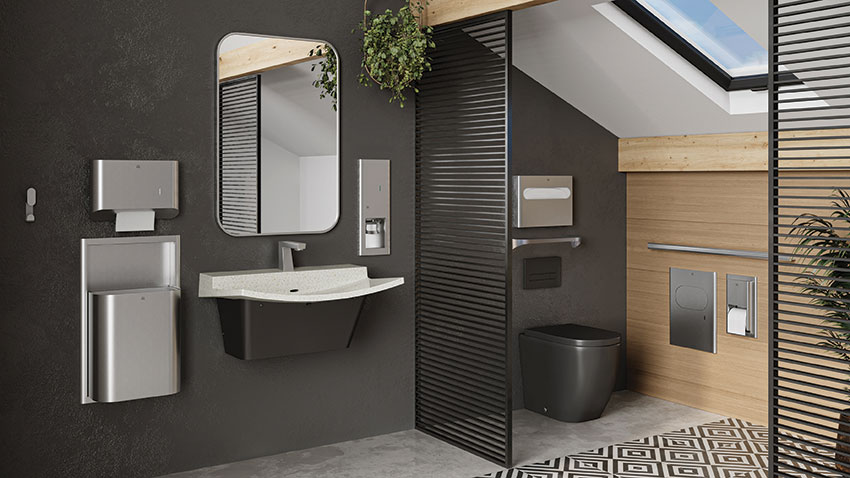
Photo courtesy of Bradley Corporation
Well-designed restrooms with functional and hygienic fixtures and accessories make a notable difference in the way building users perceive the quality of the entire building or the operation, such as a business or institution.
EXPECTATIONS OF USERS
Virtually everyone uses public restrooms in commercial buildings of all types. That means most people have had some good experiences with them and some negative experiences. Defining the difference has been the quest of one manufacturer of washroom products who conducts an annual “Healthy Handwashing Survey” to collect some unbiased, candid feedback about people’s perceptions, preferences, and problems when commercial restrooms are used. The latest survey queried 1,025 American adults between January 4-10, 2023, about their handwashing habits, concerns about the coronavirus and flu, and their use of public restrooms. Participants were from around the country and were fairly evenly split between men (45 percent) and women (55 percent). Some of the current results are summarized in the following sections.
Handwashing and Health
Perhaps Americans have a heightened awareness of handwashing following the COVID-19 pandemic, but the survey found that a whopping 93 percent of adults believe handwashing is essential to maintaining their overall health, a sentiment that’s nearly universal across gender, age, and geography. The survey also found some particular times that people think about handwashing, such as during road trips where 75 percent of adults make a conscious effort to wash their hands wherever they stop along the way. Similarly, 69 percent are diligent about handwashing when at an airport and 63 percent do the same when a special occasion occurs or the holidays approach. That suggests the importance of the need for good handwashing opportunities in a lot of building types, especially those related to travel and hospitality.

Image courtesy of Bradley Corporation
Since 2009, more Americans say they are washing their hands more diligently due to flu and/or coronavirus outbreaks.
There are other insights into people’s current feelings about health and washrooms. In particular, three in four Americans continue to be in an elevated state of germ consciousness, triggered by the pandemic. Specifically, Americans are most concerned about germs in stores (48 percent), medical facilities (44 percent), gas stations (37 percent), restaurants (34 percent) and schools (25 percent). The survey also found that 65 percent of Americans have a particularly negative impression when they see someone who doesn’t wash their hands after using a restroom. Clearly the connection between good hygiene and good health is deeply embedded in people’s minds and plays out in many commercial buildings with public restrooms.
Germ Avoidance
An interesting insight from the survey is the multiple means that people will take to avoid germs. It appears that the majority of Americans are so averse to coming into contact with germs in public restrooms that they go out of their way to avoid surfaces and touchpoints in these shared spaces. As many as 62 percent of Americans use a paper towel as a barrier to avoid touching flushers, faucets, and doors. Women are even more likely to use the “paper towel as a glove” approach, with 67 percent taking this evasive measure. Others employ sheer physical means to steer clear of germs. Reportedly, 43 percent use their foot to flush toilets, 31 percent hover over the toilet seat, and 27 percent open and close doors with their backside in hopes of avoiding germy contact. Women are significantly more likely than men to employ these actions. With so much effort going into evading germs, it’s no wonder that 82 percent of adults believe it is important to have touchless fixtures (i.e., those that operate automatically with a sensor) in a public restroom.
Business Impacts
With this enhanced sense of cleanliness and hygiene in public restrooms, it is not surprising that people tend to judge a business or other facility by the quality and cleanliness of the restrooms there. The survey discovered that almost 60 percent of Americans make it a point to stop at a business and will spend more money at the establishment if they know it has clean and maintained restrooms. Further, those aged 25-44 are even more likely to spend more at a business based on the condition of their restroom.
Conversely, there are negative business repercussions for experiencing a restroom in poor condition. More than half of Americans say an unclean or unpleasant public bathroom shows poor management and causes them to lower their opinion of the overall establishment. The 55+ age group is especially turned off by unkempt restrooms with more than 60 percent reporting a damaged impression of the overall business. To make matters worse, almost 20 percent say a sloppy restroom actually makes them less likely to clean up after themselves. Perhaps the most damaging insight for customer-facing businesses is that 52 percent say a bad restroom experience causes them not to return in the future or think twice about doing so. Another 32 percent will either tell a friend or post a comment on social media about the negative encounter. While there are a variety of restroom maintenance issues that may tarnish customers’ restroom experiences, the most common ones include clogged or unflushed toilets; an overall appearance that is old, dirty, or unkempt; unpleasant smells; and empty or jammed dispensers for soap, toilet paper, and hand towels. Clearly, finding ways to avoid those situations, both in design and maintenance, can go a long way toward improving things for any business.
Other Impacts
Businesses aren’t the only buildings that need to pay attention to these findings. Institutional buildings, such as schools, hospitals, government buildings, etc. all are subject to the same concerns and responses. For example, looking specifically at schools, where washrooms receive a lot of daily use, U.S. high school students were surveyed. The top three places that students are most concerned about coming into contact with germs are: school restrooms (63 percent); classrooms (50 percent); and the cafeteria (42 percent). Restrooms in particular seem to be the most scrutinized by students, teachers, and staff for being clean, hygienic, functional, and accessible. Up to 50 percent of high school students in the U.S. rate their school restroom facilities as poor or fair while only 6 percent describe them as excellent. High school students’ top suggestions for school restroom improvement are: 1) cleaner restrooms that are stocked more frequently with soap, paper towels, and toilet paper, and 2) restrooms in which everything is touchless – with reliable technology.
All of this information is very useful when designing washrooms that seek to meet the demands of users, maintain a positive image of the building, and keep it functioning well and profitably for the owner.
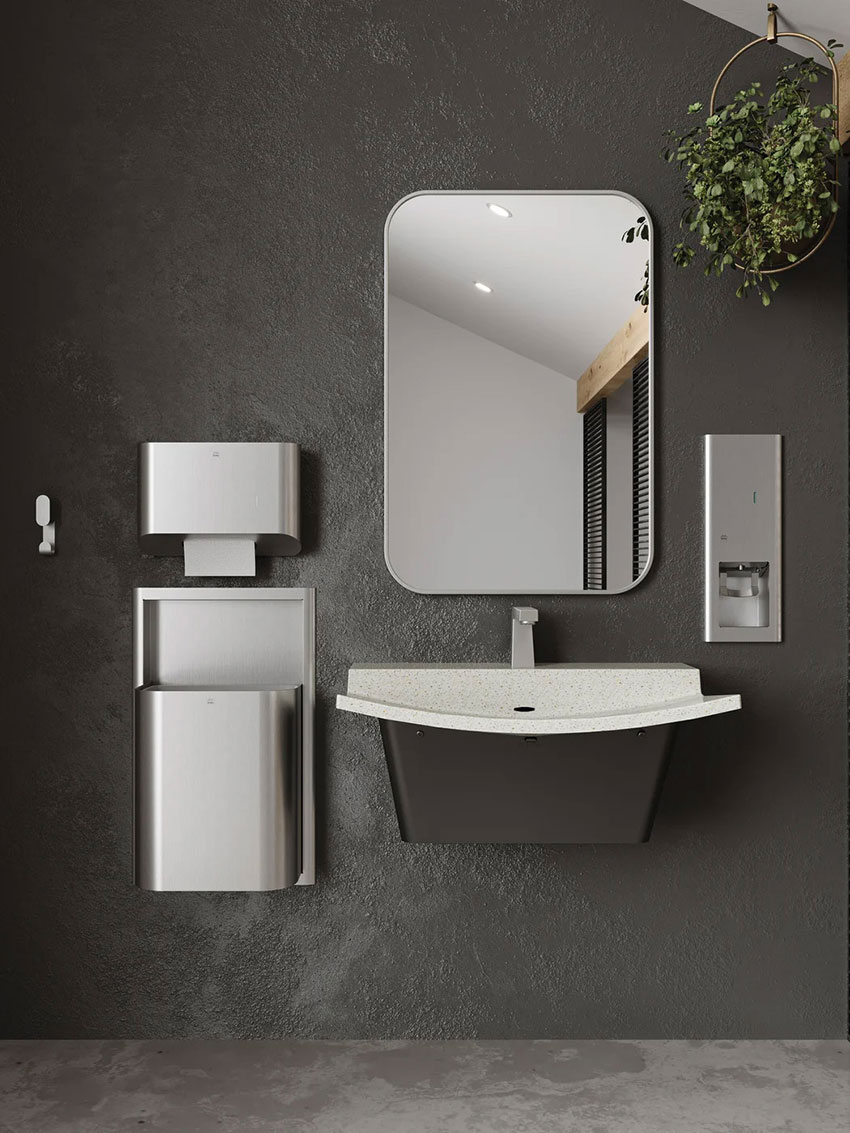
Photo courtesy of Bradley Corporation
The importance of handwashing as it relates to good health and hygiene indicates an increased need for good, coordinated design in commercial restrooms.
WASHROOM DESIGN CONSIDERATIONS
Understanding the significance and importance of washrooms leads to investigating the best ways to achieve creating well-designed and well-functioning solutions. Architects and other design professionals can focus on the best layouts and overall aspects of washrooms as a starting point. Making washrooms easy to find and accessible but appropriately separated from other spaces helps with the general impressions and usability of the rooms. From there, it is a matter of identifying the best materials, fixtures, and accessories to use to maximize a positive experience. These are the things that every person comes in direct contact with, so attention to their details makes a difference.
Clearly, all materials and products first need to address good hygiene. That means they need to be durable, easy to clean, with an attractive finish surface that doesn’t support microbial growth. Further, to avoid germ transfer, incorporating touchless operation of everything from doors to soap dispensers will go a long way toward achieving the desired results. These principles are discussed as they relate to different aspects of washroom design in the following sections.
All commercial, institutional, and industrial buildings need washrooms. Not only are they required by codes to provide basic health and hygiene services, but they are also among the most used spaces in the building. If they are given little design attention, then it usually shows up in terms of dissatisfied users, higher cleaning and maintenance costs, and unhappy building owners. However, if they are designed well, then they can create a much more positive impression of the building than many people may realize. This not only applies to the size, shape, and materials used in the space, but more noticeably, to all of the fixtures, components, and accessories that people actually use in restrooms. The aesthetic design of the total space is important but so are the functional and cleanliness characteristics of washrooms. This course addresses all of these aspects and looks at some of the most current options to coordinate the total design and functionality thus creating washrooms that are fully “state-of-the-art” using readily available systems and products.

Photo courtesy of Bradley Corporation
Well-designed restrooms with functional and hygienic fixtures and accessories make a notable difference in the way building users perceive the quality of the entire building or the operation, such as a business or institution.
EXPECTATIONS OF USERS
Virtually everyone uses public restrooms in commercial buildings of all types. That means most people have had some good experiences with them and some negative experiences. Defining the difference has been the quest of one manufacturer of washroom products who conducts an annual “Healthy Handwashing Survey” to collect some unbiased, candid feedback about people’s perceptions, preferences, and problems when commercial restrooms are used. The latest survey queried 1,025 American adults between January 4-10, 2023, about their handwashing habits, concerns about the coronavirus and flu, and their use of public restrooms. Participants were from around the country and were fairly evenly split between men (45 percent) and women (55 percent). Some of the current results are summarized in the following sections.
Handwashing and Health
Perhaps Americans have a heightened awareness of handwashing following the COVID-19 pandemic, but the survey found that a whopping 93 percent of adults believe handwashing is essential to maintaining their overall health, a sentiment that’s nearly universal across gender, age, and geography. The survey also found some particular times that people think about handwashing, such as during road trips where 75 percent of adults make a conscious effort to wash their hands wherever they stop along the way. Similarly, 69 percent are diligent about handwashing when at an airport and 63 percent do the same when a special occasion occurs or the holidays approach. That suggests the importance of the need for good handwashing opportunities in a lot of building types, especially those related to travel and hospitality.

Image courtesy of Bradley Corporation
Since 2009, more Americans say they are washing their hands more diligently due to flu and/or coronavirus outbreaks.
There are other insights into people’s current feelings about health and washrooms. In particular, three in four Americans continue to be in an elevated state of germ consciousness, triggered by the pandemic. Specifically, Americans are most concerned about germs in stores (48 percent), medical facilities (44 percent), gas stations (37 percent), restaurants (34 percent) and schools (25 percent). The survey also found that 65 percent of Americans have a particularly negative impression when they see someone who doesn’t wash their hands after using a restroom. Clearly the connection between good hygiene and good health is deeply embedded in people’s minds and plays out in many commercial buildings with public restrooms.
Germ Avoidance
An interesting insight from the survey is the multiple means that people will take to avoid germs. It appears that the majority of Americans are so averse to coming into contact with germs in public restrooms that they go out of their way to avoid surfaces and touchpoints in these shared spaces. As many as 62 percent of Americans use a paper towel as a barrier to avoid touching flushers, faucets, and doors. Women are even more likely to use the “paper towel as a glove” approach, with 67 percent taking this evasive measure. Others employ sheer physical means to steer clear of germs. Reportedly, 43 percent use their foot to flush toilets, 31 percent hover over the toilet seat, and 27 percent open and close doors with their backside in hopes of avoiding germy contact. Women are significantly more likely than men to employ these actions. With so much effort going into evading germs, it’s no wonder that 82 percent of adults believe it is important to have touchless fixtures (i.e., those that operate automatically with a sensor) in a public restroom.
Business Impacts
With this enhanced sense of cleanliness and hygiene in public restrooms, it is not surprising that people tend to judge a business or other facility by the quality and cleanliness of the restrooms there. The survey discovered that almost 60 percent of Americans make it a point to stop at a business and will spend more money at the establishment if they know it has clean and maintained restrooms. Further, those aged 25-44 are even more likely to spend more at a business based on the condition of their restroom.
Conversely, there are negative business repercussions for experiencing a restroom in poor condition. More than half of Americans say an unclean or unpleasant public bathroom shows poor management and causes them to lower their opinion of the overall establishment. The 55+ age group is especially turned off by unkempt restrooms with more than 60 percent reporting a damaged impression of the overall business. To make matters worse, almost 20 percent say a sloppy restroom actually makes them less likely to clean up after themselves. Perhaps the most damaging insight for customer-facing businesses is that 52 percent say a bad restroom experience causes them not to return in the future or think twice about doing so. Another 32 percent will either tell a friend or post a comment on social media about the negative encounter. While there are a variety of restroom maintenance issues that may tarnish customers’ restroom experiences, the most common ones include clogged or unflushed toilets; an overall appearance that is old, dirty, or unkempt; unpleasant smells; and empty or jammed dispensers for soap, toilet paper, and hand towels. Clearly, finding ways to avoid those situations, both in design and maintenance, can go a long way toward improving things for any business.
Other Impacts
Businesses aren’t the only buildings that need to pay attention to these findings. Institutional buildings, such as schools, hospitals, government buildings, etc. all are subject to the same concerns and responses. For example, looking specifically at schools, where washrooms receive a lot of daily use, U.S. high school students were surveyed. The top three places that students are most concerned about coming into contact with germs are: school restrooms (63 percent); classrooms (50 percent); and the cafeteria (42 percent). Restrooms in particular seem to be the most scrutinized by students, teachers, and staff for being clean, hygienic, functional, and accessible. Up to 50 percent of high school students in the U.S. rate their school restroom facilities as poor or fair while only 6 percent describe them as excellent. High school students’ top suggestions for school restroom improvement are: 1) cleaner restrooms that are stocked more frequently with soap, paper towels, and toilet paper, and 2) restrooms in which everything is touchless – with reliable technology.
All of this information is very useful when designing washrooms that seek to meet the demands of users, maintain a positive image of the building, and keep it functioning well and profitably for the owner.

Photo courtesy of Bradley Corporation
The importance of handwashing as it relates to good health and hygiene indicates an increased need for good, coordinated design in commercial restrooms.
WASHROOM DESIGN CONSIDERATIONS
Understanding the significance and importance of washrooms leads to investigating the best ways to achieve creating well-designed and well-functioning solutions. Architects and other design professionals can focus on the best layouts and overall aspects of washrooms as a starting point. Making washrooms easy to find and accessible but appropriately separated from other spaces helps with the general impressions and usability of the rooms. From there, it is a matter of identifying the best materials, fixtures, and accessories to use to maximize a positive experience. These are the things that every person comes in direct contact with, so attention to their details makes a difference.
Clearly, all materials and products first need to address good hygiene. That means they need to be durable, easy to clean, with an attractive finish surface that doesn’t support microbial growth. Further, to avoid germ transfer, incorporating touchless operation of everything from doors to soap dispensers will go a long way toward achieving the desired results. These principles are discussed as they relate to different aspects of washroom design in the following sections.
Touchless Fixtures
One strategy to help with hygiene in all types of restrooms is to install touchless fixtures. Sensor-activated handwashing and drying equipment addresses infection control, hygiene, accessibility, ease-of-use, maintenance, consumer demand, and cost-effectiveness. Cross-contamination of germs in restrooms can be reduced by using touch-free fixtures for everything from soap, faucets, hand dryers/towels, doors, and flushers. The hands-free concept is growing in popularity with restroom users and facility maintenance staff, especially since the pandemic.
When handwashing, easily activating soap and water with a simple hand motion─without having to touch a handle, button, or lever─keeps users from touching germy surfaces, and limits the spread of germs, fingerprint marks, and extra wear and tear. “Under any circumstance, using touchless fixtures helps to inhibit the spread of germs in restrooms and buildings,” says medical microbiologist Michael P. McCann, Ph.D., professor of biology, Saint Joseph's University. “The more we avoid restroom touchpoints, the healthier and easier our operations will be.” The most important touchless restroom features are faucets, soap dispensers, flushers, and restroom entrance doors.
Fortunately, as the demand for touchless fixtures has increased, the mechanical parts used in sensor technology have been greatly improved. While some older touchless models include sensors that deliver spotty soap and water activations, current designs incorporate advanced sensing technology ensuring continuous and reliable washing.
Jon Dommisse, vice president of marketing and strategy at Bradley Corp., reinforces the advantage of touch-free systems by noting "Our research shows that two in three people use a paper towel to avoid touching restroom door handles, flushers and faucet handles. This evasive action further demonstrates why touch-free restroom fixtures resonate so much with restroom users."

Photo courtesy of Bradley Corporation
Integrated “all-in-one” fixtures, such as the one shown here, combine touchless dispensing of water, soap, and hand drying all in one fixture over a coordinated, elongated washbasin.
Handwashing Design Choices
A significant design element in all commercial restrooms is the handwashing area. These are places that users experience directly through the senses of sight, sound, and touch. Moreover, a uniform, cohesive look neatly ties the design of the entire space together. In response, products have become available such that designers no longer have to settle for unsatisfying product design─rather, new coordinated washroom collections and accessory offerings elevate the design while providing an improved user experience. These products fall into several distinct categories as follows.
- All-in-One Handwashing Typical restrooms often incorporate separate fixtures for dispensing soap, water, and hand drying. However, innovative “all-in-one” handwashing fixtures are now available that incorporate a soap dispenser, a water faucet, and a warm air hand dryer all in one streamlined wash bar unit. They address the demand for touch-free handwashing with an integrated and streamlined design that keeps soap, water, and dryer elements all in one touch-free and easy-to-access- and-use fixture. Such all-in-one units are available in a range of finishes, shapes, and options to fit different project needs and can include a top-fill multi-feed soap system. As for washroom cleanliness and safety, they are also specifically designed to better contain water to keep it from dripping from hands onto the user, walls, and floors, thus helping to reduce messiness, slips, and falls.
- Matching Soap Dispenser and Faucet Sets If all-in-one handwashing isn’t appropriate for a given project, then well-coordinated separate fixtures may be a good choice. Well designed, matching soap dispenser and faucet sets, can unify and harmonize the look of washroom spaces, eliminating separate mismatched deck mounted soap dispensers and faucets. These identical touchless handwashing sets are available in popular touchless styles─graceful arcs, refined curves, bold angles, and a range of finishes.
- Basin Materials Designers can pair any model of all-in-one handwashing fixtures or coordinated soap and faucet sets with streamlined cast-formed basins made of a choice of materials. Currently, many designers are choosing to use resilient natural quartz-based materials or customized solid surface basins that are available in a range of sizes, styles, and popular colors. Matte-finished quartz is a fresh new option with a stone-like appearance for commercial handwashing basins. These expanded surface material options support cleanliness and flexible design since they are nonporous, smooth, and resilient with seamless construction. These qualities help prevent bacteria and mold accumulation and growth. They can also be more easily cleaned, disinfected, repaired, reused, and have a longer lifecycle than laminated products. For multi-user restrooms, new washbasin designs made of solid surface material with increased space between the handwashing areas allow for social distancing while washing hands. Such materials are sustainable, with some achieving GreenGuard certification.
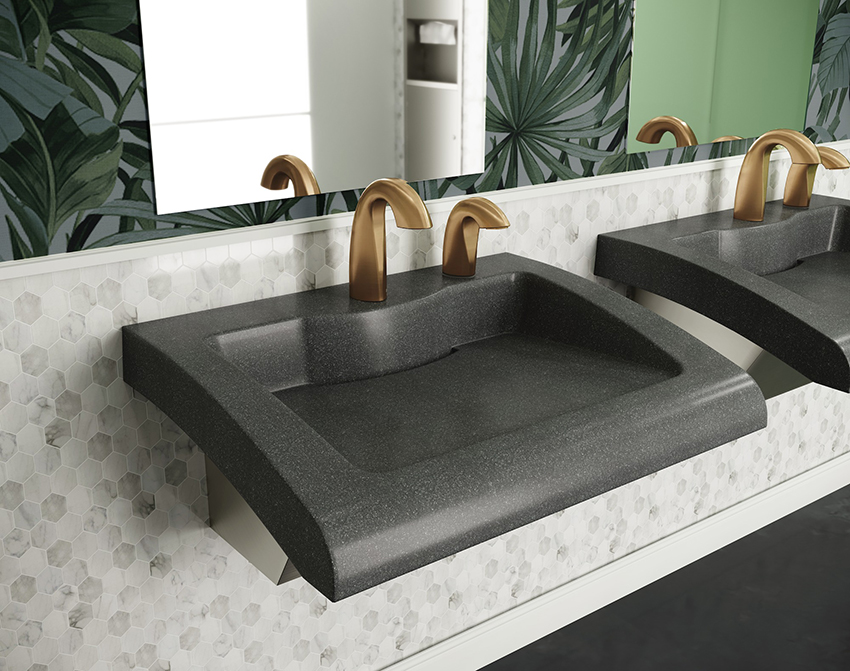
Photo courtesy of Bradley Corporation
Handwashing options can include separate but matching soap and faucet sets and a range of wash basin materials and appearances.
Coordinating Accessories
To finish off the look of handwashing and restroom design, using a complete collection of related washroom accessories from a single manufacturer is the logical way to go. The alternative is that separate, disparate, accessories from different manufacturers or vendors will be installed which may or may not provide the desired aesthetic or consistent performance. A coordinated design approach with matching style, reliable operation, and a single vendor helps assure design consistency, performance levels, and user satisfaction.
For example, one manufactured line incorporates a Euro-style pill-shape design into an entire collection, bringing in smooth curves and soft edges. The collection includes the full set of restroom accessories such as grab bars, paper dispensers, receptacles, shelves, soap dispensers, and even LED mirrors, all offered with a harmonious and sophisticated aesthetic. The minimalist design of such accessories can seamlessly integrate into any commercial washroom setting whether a boutique hotel, eclectic coffee shop, high-end retail store, upscale restaurant, or corporate office.

Photo courtesy of Bradley Corporation
A collection of coordinated washroom accessories can be paired with other washroom elements to create a complete, cohesive, and elevated design.
Handwashing Accessories
In addition to water, all handwashing stations need several other features to be functional and useful.
- Soap Dispensers If matching faucet/soap dispensers aren’t selected, then soap is usually provided from a separate wall mounted dispenser. These essential accessories are sometimes deferred to the maintenance staff with the idea that they will get them “for free” from the vendor who supplies the soap. Not only is that often a false economy, it belies the effort for a coordinated design. Selecting dispensers that are designed to complement the rest of the accessories while offering a comfortable user experience is almost always a more appealing solution. They are available in hands-free (touchless) surface-mounted models as well as recessed manual options. Most commercial dispensers can accommodate bulk liquid or foam soap or gel sanitizer.
- Hand Drying Once hands are washed, most people prefer to have them dried promptly and are often unhappy if there are no paper towels in a dispenser to do so. Sometimes, there is a conscious decision by owners to be more sustainable by using only high-efficiency air dryers and avoiding paper towel usage (and resulting trash removals). All-in-one touchless solutions which include air-powered hand drying are particularly appealing in this regard. If all-in-one fixtures are not used, then a separate drying solution is needed. Wall-mounted, touchless air dryers can be selected in some cases that match the style and appearance of the rest of the accessories and provide the needed performance characteristics. If paper towels are selected for use, either instead of or in addition to air dryers, then not only are towel dispensers needed, but trash containers as well, preferably in matching style and finish to the rest of the washroom. In some cases, combination towel and trash units that match the rest of the accessories are also available which can be more unifying than disparate or purely utilitarian choices.
Mirrors
- Almost all handwashing stations include a mirror above the sink or wash deck. That mirror can be a random choice, or it can be coordinated with other accessories, so it enhances the overall design. Keep in mind that a full-size/60-inch mirror hung vertically can solve ADA access to the mirror if it can’t be mounted at the right height over the sink. Stainless steel frame mirrors are readily available in a variety of sizes plus the option of a shelf below them to provide both an attractive amenity and functionality. Frameless mirrors with soft rounded corners are available on some product lines too which can complement the curves of a collection of accessories. Frameless mirrors provide the appearance of floating on the wall creating a weightless, refined look. They are also available in multiple sizes and with an optional shelf.
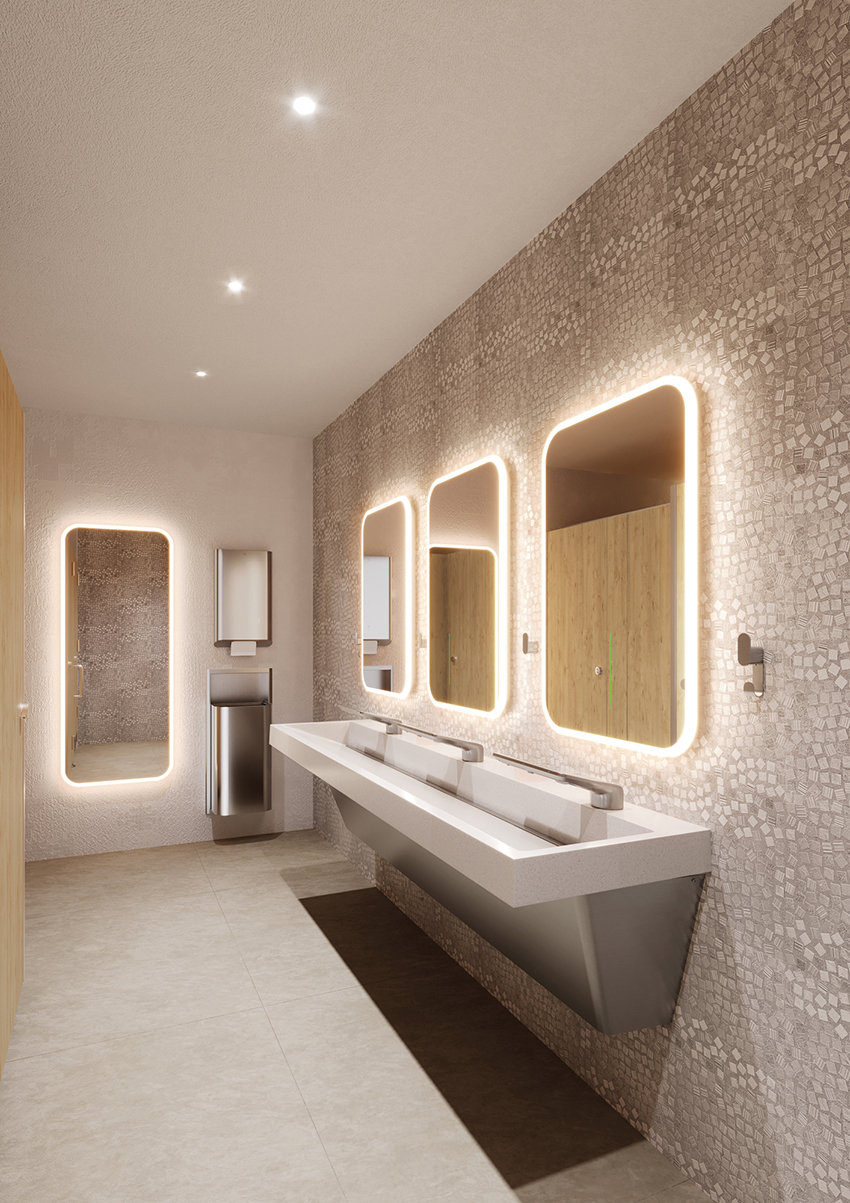
Photo courtesy of Bradley Corporation
Washroom mirrors with perimeter LED lighting can provide a superior look and plenty of light for applying make-up or other sink-related actions.
Recognizing that there is likely to be a light fixture near the wash station either in the ceiling or on the wall, there are some elegant alternatives that include LED lighting around the perimeter of the mirror. Such mirrors can include radiused corners and polished edges and are available in a wide range of sizes and with an optional shelf. Vertical or horizontal mounting allows for added flexibility.
Designing for Privacy
With privacy emerging as a key user preference in commercial restrooms, privacy partitions add extra height, width and added discretion to create the feeling of a private individual room. Further, the concept of gender neutral or all-gender restrooms, which has gained traction in recent years, also calls for an elevated level user privacy. Some design options for inclusive restrooms include individual rooms with locking doors or a larger communal handwashing space with separate stalls.
One popular layout is based on European restroom models with gender-neutral layouts that form a perimeter around communal washing stations to facilitate one-way traffic and minimize cross-traffic. Corridor concept entries and exits, as well as automated doors, are also design considerations.
The IAPMO/ANSI/CAN Z124.10 standard specifies the level of privacy and security for the users of water closets and urinals. This standard addresses the need for partitions to minimize the open space between stalls, use of occupancy indicators on stalls, and doors that lock to support privacy. Increasingly, using privacy partitions helps architects create comfortable, durable restroom retreats for all users.
A new preference for European-style partitions gives restroom guests a fresh and welcomed surprise in commercial restrooms. In addition to being nearly full height for enhanced privacy, different product selections also add sophisticated style, elegance, and resiliency to restroom designs. Several different types of partitions are currently available.

Photo courtesy of Bradley Corporation
European-style partitions provide very high degrees of privacy in restroom design while incorporating separate communal handwashing areas.
Toilet Stall Accessories
Just as with handwashing areas, toilet stall areas require appropriate attention for the necessary items beyond the plumbing fixture. Once again, finding a series or collection of accessories that match the rest of the washroom will elevate the design overall with a more consistent and fresher look.
- Paper Dispensers These dispensers need to be replenished regularly so units that operate for quick and easy refills will always be welcomed by maintenance staff. Users may appreciate a second or “back-up” roll being available in the same unit in case the supply runs low. Units that are recessed may be preferable where possible, but surface mount units can be just as functional.
- Seat Cover Dispensers With the increased sensitivity to avoiding contact with surfaces, flushable paper seat covers are often a welcome sight to many users. The material for the cover, the ability to be recessed or surface mounted, and the ease of replenishing the supply should all be considered when selecting these units.
- Sanitary Product Disposal Most building owners will request that sanitary products not be flushed to avoid plumbing blockages. Therefore, alternative disposal is needed. Adding a separate, dedicated waste fixture, often near the paper dispenser, is a logical and needed accessory.
- Coat Hooks It is common that people may need to remove a coat or hang something up while inside a toilet stall. While it is a small thing to add a hook or peg in a convenient location, it may be highly appreciated and add to an overall positive impression if it is included.
- Shelves People often enter a stall with items such as a purse, phone, or wallet, and prefer not to place it on the floor or on top of toilet paper dispensers, making the addition of a small shelf a useful feature. Shelves can be made out of stainless steel for easy cleanability and some even include integral hooks so they can perform dual functionality.
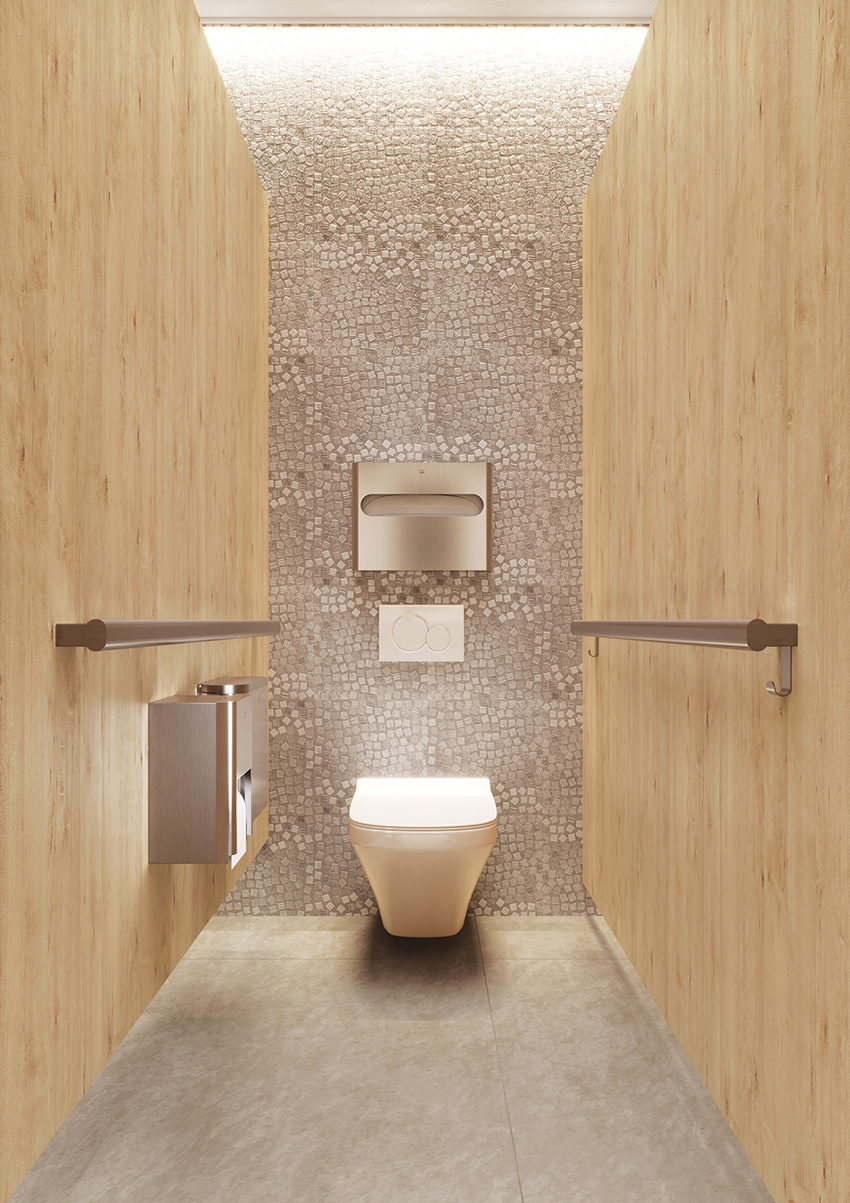
Photo courtesy of Bradley Corporation
Accessories in the toilet stall area are necessary but can be selected to match the overall design intent and provide an appearance beyond utilitarian.
Accessibility
All commercial public restrooms need to meet requirements for accessibility, both as a matter of building code requirements and to coordinate with the Americans with Disabilities Act (ADA). That means first that the accessible route into and within the restroom needs to have the proper clearances and space for wheelchair maneuverability. Next, the location of the fixtures and accessories needs to fall within the prescriptive ranges of height and clearances for people in wheelchairs, as well as ambulatory people, to use them and reach them. Manufacturers of restroom accessories and fixtures are usually quite well aware of the requirements and have developed products to be sure that they can be installed in a manner that meets the accessibility requirements.
- Grab Bars The accessory that is specifically designed for accessibility are grab bars, typically placed around the toilet or a shower. It used to be that there was only one option for such bars that usually looked quite institutional. Manufacturers have since taken a closer look at their products and now offer variations that still meet the accessibility requirements but can also provide an appearance that is more consistent with the rest of the washroom. This creates not only a more cohesive look, but it is also consistent with the principles of Universal Design, which contend that accessibility features should simply blend in and be part of a good design that everyone can use and benefit from. The grab bars, in various lengths, may be mounted horizontally or vertically as needed. The updated design makes it easy to consider providing more than just the code minimum and focusing on the needs of the users. New grab bar designs can also include integrated hooks for added functionality.
Overall, comprehensive collections of washroom accessories with a uniform look give designers more options and flexibility to meet project criteria while expressing individual their own visions. The expanded selections of materials, colors, finishes, and textures further accentuate and customize commercial washroom designs, also giving designers more creative freedom.

Photo courtesy of Bradley Corporation
Washrooms that function well and are easy to clean and maintain are deemed to be a very worthwhile investment due to their high daily use.
WASHROOM FUNCTIONALITY
In addition to aesthetics, product craftsmanship, and quality considerations play a tremendous role in washroom functionality. This is because the washrooms are likely used repeatedly every day by a lot of people, which requires ongoing cleaning and maintenance. Hence, the selection of fixtures, materials, and finishes all need to be specified to suit the demands of the commercial, institutional, or industrial setting where the washroom is located.
In light of their high use, it is a bit of a myth that first cost is always a deciding factor for specifying products in restrooms. It is obviously true that automatic or “touchless” handwashing products typically have higher upfront costs because of their electronics package. However, ongoing maintenance and related costs are considerably less expensive than manually operated models because touchless fixtures are easier to keep clean, maintain, and service than manually activated fixtures. In retrofit situations, automated technologies may require some modifications to the existing plumbing and electrical systems, but that is usually relatively straightforward.
There is also a misperception that touchless models deliver spotty or false activations. Fortunately, the mechanical components used in sensor technology have been improved over the past several years. Specifically, faucets incorporate advanced sensors and options for ultra-low flow demands. While some older touchless models include sensors that deliver unreliable soap and water activations, current designs incorporate innovative sensing technology ensuring continuous washing, and less leftover soap in and around the basin.
One final misconception is that investing in high quality restroom products and designs has a low payback. According to one manufacturer, end users are so sensitive to the appearance and cleanliness of restroom environments, they will even put their money behind it. Recall that the consumer survey indicated that 60 percent of Americans said they would willingly spend more money at a business with clean, well-maintained restrooms. Another 60 percent say that when out running errands they take restroom breaks at a business they know has “good” restrooms.
Durable Materials
When looking at the materials used for handwashing fixtures, popular and attractive finishes are produced with physical vapor deposition (PVD). This is an advanced process that creates a molecular bond to the fixture, creating a resilient coating that will not corrode or fade. In addition to a chrome finish, there is a selection of five popular PVD finishes including brushed bronze, brushed stainless, brushed black stainless, brushed nickel, and brushed brass available. PVD coatings are a more sustainable way to finish metals than traditional electroplating.
Of course, the durability of touchless restroom fixtures is of paramount importance too. In 2021, for example, many schools experienced an uptick in vandalism. This was due to a destructive "Devious Licks" challenge on TikTok, which encouraged students to record and post a video of themselves stealing or vandalizing school property. Unfortunately, bathroom equipment like soap dispensers, faucets, and toilets were targeted. Those that were durable enough to withstand the abuse survived, but many others did not and had to be replaced at the expense of the schools. This certainly helps make the case for schools to use high-quality, durable restroom equipment that holds up against vandalism attempts.
In response to this need, look for trim plates and anti-rotational pins to also discourage faucet vandalism. In addition, many soap and faucet sets are manufactured with hidden sensors to discourage tampering. They are also made with durable cast brass spout construction with PVD finishes that are highly resilient and withstand wear and tear. Similarly, electronic roll towel dispensers are designed with several anti-vandalism features, which also help improve maintenance. These dispensers control the amount of paper towel used, deterring vandalism and reducing waste. For example, sometimes people grab handfuls of towels from a dispenser, toss them in the trash or a toilet, leave them on the sink, or drop them on the floor. An automated towel dispenser delivers a set amount of paper, reducing excessive usage and saving time on refilling. Another anti-vandalism “time out” feature locks out the dispensing of paper towels after being activated three times in a row.
For washbasins, both natural quartz and solid surface materials are cast-formed, so they are able to be specified in many attractive shapes and forms, expanding flexible design options. Both materials can last a lifetime and can easily be repaired and renewed, thus minimizing the need for replacement or disposal. Products made of solid surface are completely molded including bowls, overflows, backsplashes, and aprons, eliminating fabrication waste and the use of sealants and adhesives. Like natural quartz, solid surface is also a nonporous material which means that it will not support mold, mildew, or bacteria accumulation.
Maintenance
Reducing waste and maintenance time is directly related to saving money during building operations. By limiting the amount of products used, like paper towels or soap, less time is spent on refilling and less money ordering new products. Some handwashing models use a smart sense soap system with LED light indicators to display low soap and battery, making maintenance more predictable and efficient. A top-fill multi-feed soap system can also be used with a large capacity 1.3-gallon (5.0 L) tank that can supply up to six soap dispensers at once, which is a time-saver and game-changer for maintenance staff. Using all-in-one units or only using air drying for hands can eliminate the need for any paper towels at all, thus saving on trash and the need for emptying trash containers. In all, well-selected and coordinated restroom fixtures and accessories can require less time cleaning, ordering, refilling, and restocking, all creating opportunities to save money.
Kris Alderson, MBA, LEED AP, senior marketing manager at Bradley, sums things up this way: “In addition to meeting end-user expectations for hygiene, operational efficiency is another key goal for restrooms. Over-stretched maintenance staff are on the lookout for restroom products, technologies, and features that optimize maintenance, cut costs, and make their jobs easier. Sustainable product designs like all-in-one handwashing models that reduce maintenance and paper towels, as well as new top-fill multi-feed soap systems, can help maximize efficiency and simplify maintenance.”
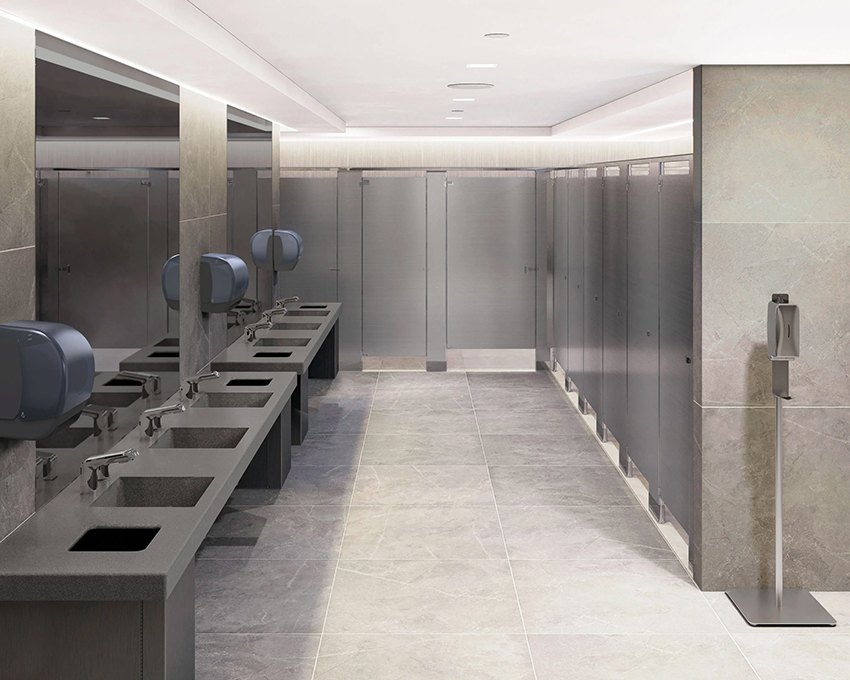
Photo courtesy of Bradley Corporation
High-usage restrooms, such as this one at an airport, can be specified to use state-of-the-art touchless fixtures and accessories while still meeting the needs for a coordinated aesthetic, easy maintenance, and positive user experience.
SPECIFYING STATE-OF-THE-ART WASHROOMS
Based on everything discussed so far, it should be clear that it is quite possible to specify washroom fixtures and accessories that meet the needs of both building users and owners. However, keep in mind that not all products are created equally. It is important to understand the specifics that have been discussed here and specify the most relevant products to suit a project. This means incorporating the proper language for durability, hygiene, maintenance, and other performance requirements as well as the design criteria. Some of the relevant items to address in a standard three-part specification format are highlighted as follows.
Part 1: General
The scope of the specified work can include all preparation, product choices, and final installation. In terms of specifying performance, the appropriate testing standards should be referenced not only for the plumbing products, but also for all accessories that are secured or attached to the walls, floor, doors, or other surfaces.
Submittals for washroom fixtures and accessories should include the usual manufacturer’s data and information for all products used plus samples with color and texture data to confirm that the correct appearance is being achieved.
Quality assurance is clearly an important part of any field-installed system and the same is true here. Installers should have qualifications acceptable to the manufacturer. Evidence of such qualifications can be requested as a submittal, but it is important that the people who are actually in the field are the ones with the qualifications and experience needed.
On-site protection of products should be carried out according to the manufacturer’s instructions and recommendations, particularly if any standard limited warranty is called for.
Part 2: Products
When multiple types of washroom fixtures and accessory products are used, then they each should be identified by type in the specifications, and the location of each type needs to be clearly called out in either the drawings or specifications. The details of the specified products can include:
- The specific type of products being called for (i.e., all-in-one fixtures, matching sets, types of accessories, etc.), should be identified for each product used. In addition to the functional description, the design selections for color, finish, style, etc. all need to be identified.
- The specific performance criteria for each product including capacities, sensor types, vandalism resistance, and any other needed criteria can be specified.
- Other requirements including the details of cleaning and maintenance removal for the products can be called out.
Part 3: Execution
As with any installed products, the installation requires multiple steps, which need to be clearly articulated in the specification in order to achieve the best results.
- Examination and Preparation: The importance of this step should always be stressed. In addition to the architect and mechanical engineer (as appropriate), the installer should review and examine the surface conditions that may affect the installation or the overall performance of the products. Any issues will need to be corrected if they are found to be out of compliance with stated requirements.
- Installation: All fixtures and accessories should be secured in place according to the manufacturer’s instructions and installation manuals. Those should be consulted to ensure that the products are installed to meet code requirements and other conditions for a successful project.
- Protection: Once installed, the products should be able to withstand normal activity but should be protected from any remaining construction work that could adversely affect them.
- Cleaning: Upon completion, the surface of all washroom fixtures and accessories should be cleaned of any construction or miscellaneous dirt, debris, etc., as the manufacturer may suggest.
When specified and installed correctly, the washroom products will provide the desired look, the long-term performance characteristics, and the user satisfaction levels that are intended.
CONCLUSION
Americans remain very concerned about good hygiene in commercial washrooms as a means to help protect their health. This is evidenced by recent surveys that indicate an overwhelming majority react favorably to well-designed washrooms and will avoid places that have poorly designed or maintained restrooms. There are numerous options to help respond to this need including touchless fixtures and accessories, hygienic, easy-to-clean materials, and all-in-one wash stations that eliminate waste and improve user experiences. Providing attentive restroom design in buildings of all types provides several benefits to facility stakeholders, including owners, users, employees, and visitors/guests. Those benefits range from infection control/hygiene, restroom functionality, long-term durability, improved maintenance, elevated aesthetics, consumer satisfaction, greater user privacy, and business return on investment.
Peter J. Arsenault, FAIA, NCARB, LEED AP is a nationally known architect and a prolific author advancing positive acoustical experiences through better building design. www.pjaarch.com, www.linkedin.com/in/pjaarch























